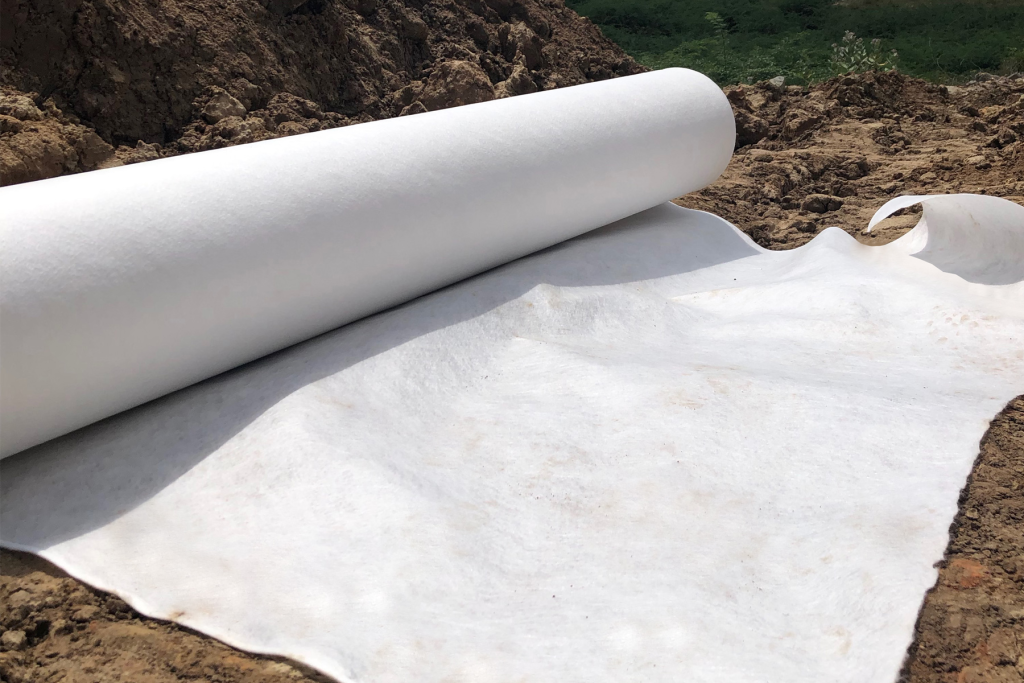Geotextiles are essential materials in civil engineering, construction, and environmental projects. They provide filtration, drainage, and soil stabilization, but one common question arises: Can water penetrate geotextiles? The answer depends on the type of geotextile fabric, its structure, and its intended application. This article will explore how water interacts with geotextiles, the differences between woven and nonwoven geotextiles, and why understanding permeability is crucial for selecting the right material.

I.Permeability of Geotextile
Geotextiles are designed in such a manner that they permit water to pass through but prevent soil particles from passing. Not all geotextiles are equally permeable to water, however. A geotextile fabric is permeable based on its manufacturing process, pore size, and material.
– Permeable Geotextiles: These are able to allow water to percolate through very easily and hence are most suitable for drainage applications.
– Less Permeable Geotextiles: These restrict the flow of water, which is useful where soil stabilization and erosion control are required.
Since water movement is pertinent in the majority of projects, getting the right type, whether woven or non-woven, can make a significant difference in terms of performance.
II.Woven vs Non-Woven Geotextile: How They Impact Water Flow
When deciding on a geotextile material, one of the most important decisions is between woven vs nonwoven geotextile. Both include various attributes that regulate water entry.
Woven Geotextiles
Woven geotextiles are manufactured by interlacing synthetic yarns in a close, grid-like pattern. This configuration acquires high tensile strength but can obstruct the passage of water depending on the weave density.
– Water Penetration: Woven geotextiles tend to have lower permeability compared to non-woven ones. They are better suited for applications requiring strength as well as moderate filtration, i.e., road stabilizing.
– Best Uses: Specifically designed for heavy-duty areas such as parking lots, roads, and embankments where soil separation is required.
Non-Woven Geotextiles
Non-woven geotextiles are fabricated through mechanical, thermal, or chemical bonding between fibers. They result in more porous structures allowing easier flow of water.
– Water Penetration: Permeability in non-woven geotextiles is usually high, suited best for use in drainage systems, French drain applications, and horticultural work.
– Best Uses: Suitable applications for filtration layers, drainage layers, and for the control of erosion where speedy passage of water is needed.
Since both types are used for different purposes, engineers must consider whether water penetration is a priority first before selecting a hot sale geotextile to work on their project.
III.What Affects Water Penetration in Geotextiles
Other than the simple non woven vs woven geotextile model, there are various factors that affect how well water can penetrate geotextile fabric:
1. Pore Size (AOS – Apparent Opening Size)
– Larger pores allow greater water flow but can allow fine soil particles to pass.
– Smaller pores limit water but offer more filtration.
2. Material Composition
– Polyester and polypropylene geotextiles are typical, the latter having improved chemical resistance.
3. Thickness and Weight
– Denser geotextiles restrict water flow, while less dense ones enhance permeability.
4. Hydraulic Conductivity
– Measures how readily water travels through the fabric—a critical requirement for drainage applications.
Understanding these parameters ensures that the chosen hot sale geotextile meets the project’s hydraulic requirements.
IV.Applications Where Water Penetration Is Relevant
Different projects need varying degrees of water permeability. Here’s how geotextile fabric works in key applications:
Drainage Systems
Non-woven geotextiles are often used in drainage systems because they are water-permeable without clogging the soil.
Erosion Control
Woven geotextiles hold soil in place but still permit some water flow, reducing erosion on slopes.
Landscaping & Agriculture
Permeable geotextiles improve drainage and aeration in the soil to support improved plant growth.
Road Construction
Weaved geotextiles provide the road with strength and regulated water flow to prevent the road from being damaged.
Due to each use being unique, selecting the right hot sale geotextile is required to achieve long-term results.
Testing Geotextile Permeability
Engineers generally test geotextiles before installation to determine water penetration ability to project specifications. Some common methods are:
– Permittivity Test: Quantifies volume of water that flows through under hydraulic gradient.
– Gradient Ratio Test: Evaluates tendency to clog with time.
– ASTM D4491: Standard test for rate of water flow.
Tests confirm whether a geotextile fabric is suitable for project requirements.
Conclusion: Choosing the Right Geotextile for Water Percolation
So, do water geotextiles permit penetration by water? The reply is yes—but the degree of penetration depends on the fabric of the geotextile and its properties. Woven geotextiles offer strength with intermediate water flow, while non-woven geotextiles are best in high-permeability situations.
To select the hot sale geotextile, always consider:
– Project requirements (drainage, filtration, or stabilization)
– Material type (non woven versus woven geotextile)
– Water flow requirement (high or controlled water flow)
Knowing these, engineers and contractors can optimize the best performance possible out of their projects. Road building, landscaping, and even erosion control uses will have their strength and water permeation perfectly paired with the right geotextile.
If you need top-of-the-line geotextiles that meet your project specifications, browse our range of long-lasting and porous solutions today!